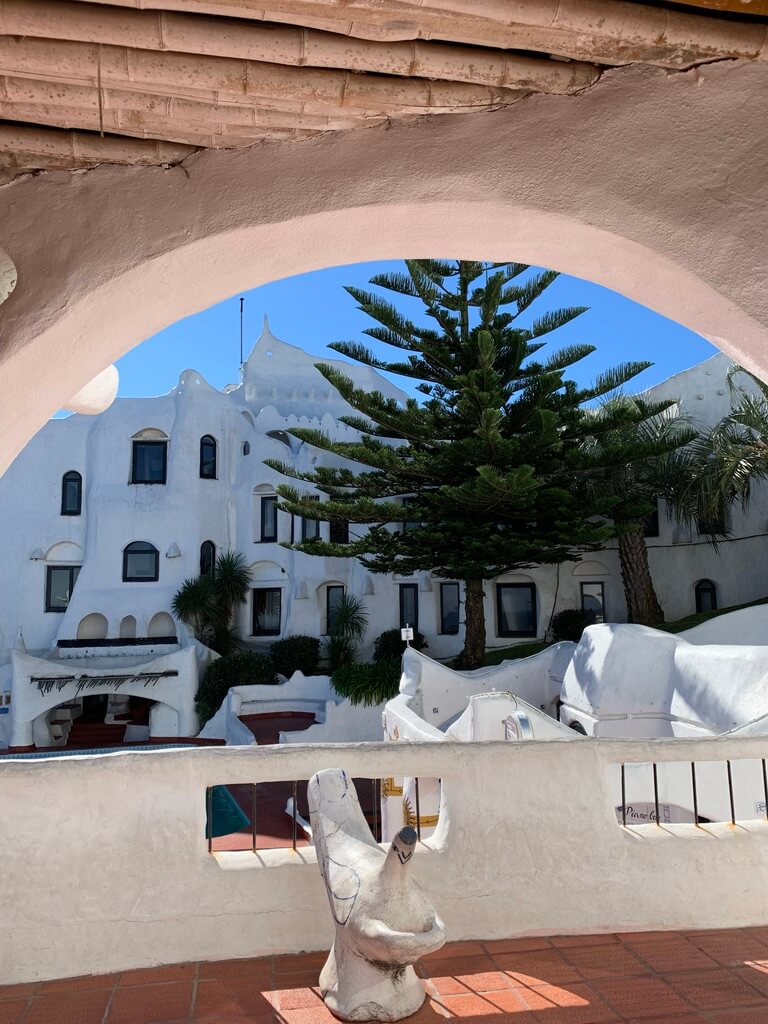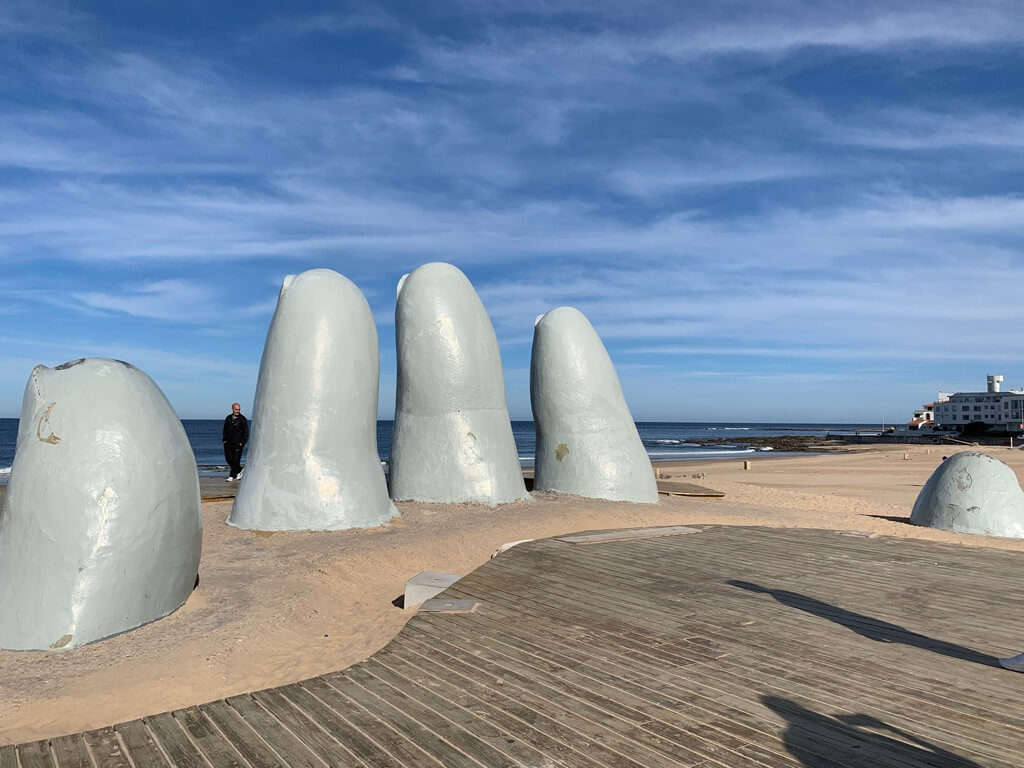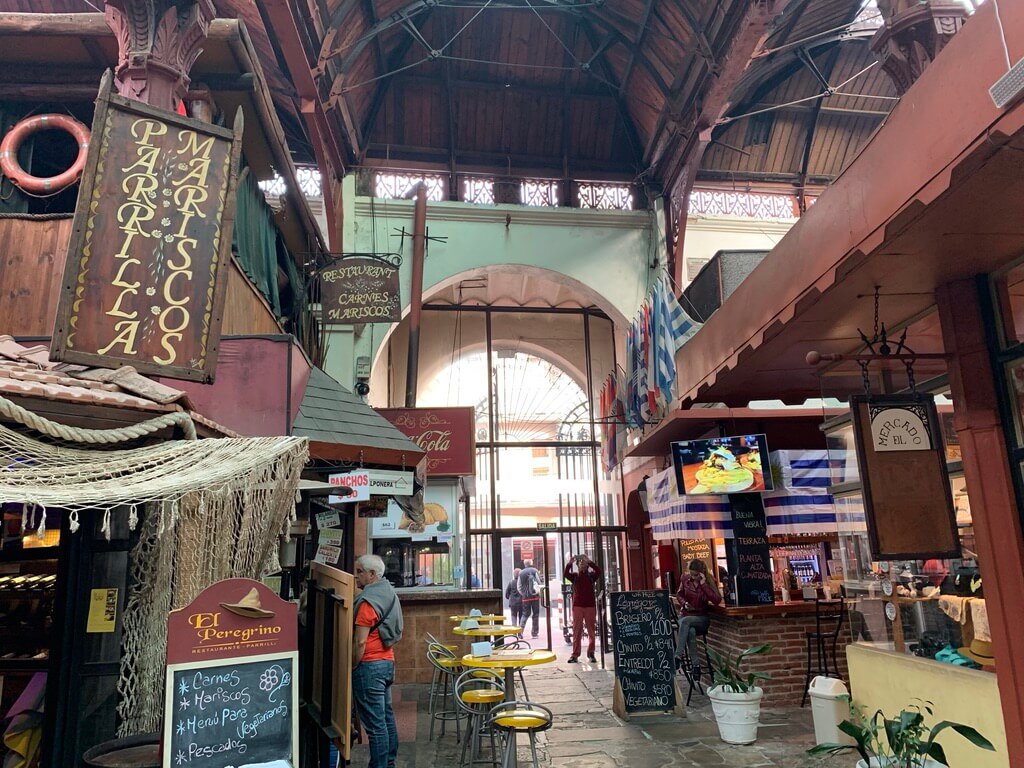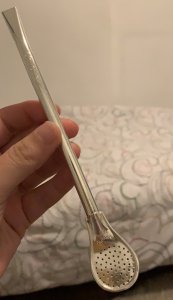If you’re planning to visit Argentina, Bolivia, or Chile, you should absolutely consider adding on a few days in Uruguay at the beginning of your trip.
We kicked off an epic 3-week mother-daughter trip with a weekend in Montevideo and Punta del Este, and it was super easy to take the Buquebus ferry to Buenos Aires right from Montevideo when we left. The ferry leaves from Colonia de Sacramento, Uruguay, which is an adorable little town that’s absolutely worth a visit. For a great day trip guide from our friends Dan and Beck at Travel Made Me Do It, check out this link.
While in Uruguay, we were able to visit Punta del Este as well as Montevideo, all in a long weekend’s time! Check out all our tips and tricks below. Enjoy!
Day 1: Casapueblo & Punta del Este
Table of Contents
ToggleArriving at Montevideo International Airport (MVD), you can either take a bus to Punta del Este or rent a car. We opted to rent a car because there were 3 of us, and the cost of the rental was comparable to 3 round-trip bus tickets. We ended up being very glad we went with the car option, because it gave us the freedom to drive all over the area, and visit several sites that would have been difficult without the car.
 From MVD, we drove about an hour to get to Punta del Este, a beautiful beach-front town known as “the Monaco of South America.” Fancy. Prior to going into the town itself, we stopped at Casapueblo, the house-turned-museum of Carlos Páez Vilaró, a famous Uruguayan artist and sculptor. Casapueblo is a huge, sprawling, and whimsical structure located in Punta Ballena (a little over 10 kilometers away from Punta del Este), and wow did this place exceed expectations. With your admission ticket, you first start with watching a film about the artist and his life, and can then access various rooms and terraces, seeing his art as well as a variety of other pieces. All the while, you are surrounded by gorgeous vistas of the Atlantic Ocean. The architecture reminded us a bit of Gaudi’s works in Catalunya, but this place definitely has a character of its own! Take your time exploring here, as there is so much more than meets the eye in each room. After finishing up in the museum, we spent some time just walking around the area. Casapueblo and the road next to it is the only thing around really, so make sure to take in the uninterrupted views of the landscape and the ocean from outside the museum.
From MVD, we drove about an hour to get to Punta del Este, a beautiful beach-front town known as “the Monaco of South America.” Fancy. Prior to going into the town itself, we stopped at Casapueblo, the house-turned-museum of Carlos Páez Vilaró, a famous Uruguayan artist and sculptor. Casapueblo is a huge, sprawling, and whimsical structure located in Punta Ballena (a little over 10 kilometers away from Punta del Este), and wow did this place exceed expectations. With your admission ticket, you first start with watching a film about the artist and his life, and can then access various rooms and terraces, seeing his art as well as a variety of other pieces. All the while, you are surrounded by gorgeous vistas of the Atlantic Ocean. The architecture reminded us a bit of Gaudi’s works in Catalunya, but this place definitely has a character of its own! Take your time exploring here, as there is so much more than meets the eye in each room. After finishing up in the museum, we spent some time just walking around the area. Casapueblo and the road next to it is the only thing around really, so make sure to take in the uninterrupted views of the landscape and the ocean from outside the museum.
Note: if you didn’t rent a car, you can take the Codesa #8 bus, which drops you about 2 kilometers away from the entrance. It is absolutely gorgeous to walk around the area of Punta Ballena, too!
From Casapueblo, we drove into Punta del Este. We visited in late May, which is winter in the Southern Hemisphere, so we felt like we had the whole town to ourselves. Due to its beach location, the temperatures are still very temperate, so it was a wonderful time to visit. We started out our time here with checking out La Mano, a sculpture by Mario Irarrázabal depicting five fingers emerging from the sand, located at the Parada 1 marker at Playa Brava. This is largely considered the “symbol of Punta del Este,” and it was so, so neat to see up close! We really enjoyed walking around the various fingers and checking out the differences between them. Tip: Our photos taken behind the sculpture came out much better than the ones in front.
This area often gets very crowded, so you may have to think fast to get a photo without others in the background. From here, two can’t-miss beach areas are the aforementioned Playa Brava (Angry Beach) and Playa Mansa (Calm Beach). As their names suggest, Playa Mansa is serene and calm, and Playa Brava is a popular surfing area due to its more turbulent water. Interestingly, it is said that Irarrázabal originally conceived of his hand sculpture as “Monumento al Ahogado,” or Monument to the Drowning Man, placing it where he did on the beach to warn visitors of the unpredictable and sometimes dangerous swimming conditions here. It is also lovely to walk and people-watch around the harbor area and all around the peninsula here.

Next, we drove around in search of a bite to eat, since we had gone straight from the airport to visit Casapueblo and La Mano. Punta del Este is famed for being very, very pricey. However, a big perk of visiting in the off-season is that we did not have this experience at all. We got a very locals-only vibe while we were there, and were in total shock when we heard that up to 400,000 people visit in December and January! We ended up stopping for a quick bite in the port area, which has lovely wooden promenades, boats bobbing in the water, and a variety of restaurants at all price points to choose from. There are a lot of swanky options here, but we ended up choosing a lovely fast-casual home-made pasta joint called Piazzarella. It had delicious ravioli and other pasta options for much cheaper prices than its neighboring locales, as well as a beautiful view of the water.
After lunch, it’s an easy drive over to La Barra, a beach accessed by a bridge of the same name. This bridge is really something– it twists and undulates while you drive over, making you feel like you’re on a rollercoaster!
While in Punta del Este, we stayed at a small no-frills hotel called Hotel Bravamar at Parada 2, found on Booking.com. It was a nice stay overall and the personnel are very kind. We also really enjoyed the included breakfast– especially the dulce de leche, of course! We paid $60 for a room with 3 twin beds in the off-season, but this price probably goes up significantly in other months.
Day 2: Montevideo
We departed Punta del Este fairly early after breakfast, and drove to return the car at the MVD airport. From there, we took an Uber into town to Montevideo proper. Our adorable Airbnb hosts, Beatriz and her husband Adhemar, allowed us to check in early, so we dropped off our luggage and then walked over to the Plaza Independencia nearby to meet up with our Montevideo Free Walking Tour at 10AM. If you’ve read our other posts, you know that we are huge fans of tip-tours, and often take advantage of them on our first day in a city to start getting to know a new place. This tour was excellent– we super recommend it if you’re in Montevideo! There’s no need to sign up in advance, you can just meet the guides under the monument to José Gervasio Artigas (Uruguay’s national hero who fought for independence from Spain) a few minutes prior to 10AM or 3PM each weekday.
The tour takes about 2.5 hours, and walks you around everywhere you need to see in Montevideo’s Ciudad Vieja (or the old city.) The tour meets and starts out in Plaza Independencia, where you’ll learn all about Montevideo’s various independence movements and a brief history of Uruguay, as well as take a look at the towering Art Deco Palacio Salvo, a National Heritage Monument.
From there, you will move on to see Teatro Solis (a gorgeous theatre) and Templo Inglés, and then stroll down Peatonal Sarandí (a pedestrian-only area) to Plaza Matriz, where you will learn all about Uruguay’s colonial government and religious history at the Cabildo.
Next, you will walk to the Plaza Zabala, Banco República, and finally culminate your tour in the very neat Mercado del Puerto part of the city. This is an excellent endpoint to the tour, because there is a lot to explore in this area. We opted to get a quick bite to eat inside the market, and enjoyed peeking at some traditional Uruguayan artisanries and souvenirs, as well as enjoying some ice cream. This was traditionally a meat market, so a lot of the restaurants are very meat-centric (perfect for 3 vegetarians, teehee!) We also found a lot of the vendors to be very aggressive here, so it’s best to pick a place to eat quickly– they are all pretty much the same.
Tip: we recommend looking rather than buying here— these are definitely tourist prices, and we found much more reasonable shopping areas elsewhere. From the Mercado del Puerto, it’s fun to stroll around a bit around the cobbled streets and pop into various little shops or window-shop as you walk. 
We spent the rest of the afternoon and evening purchasing some groceries, having dinner, and relaxing with our Airbnb hosts after a very packed few days. We really recommend staying with Beatriz and Adhemar if you’re in Montevideo. Their apartment is gorgeous, they are absolutely lovely people, and it’s one of the best stays we’ve ever had at an Airbnb. The rooms had a mini-fridge stocked with water bottles and chocolate (the way to our hearts!) and it was located in an excellent location a few blocks from Plaza Independencia and the Rambla area. We paid about $35USD per night for the 2 bedrooms, and stayed 2 nights.
Day 3:
First thing, we walked over to the Mercado de los Artesanos and spent a lovely morning exploring all sorts of handicrafts and beautiful artisan works. Tip: It’s important to note that they have a somewhat curious way of charging you for what you buy here– if you choose, for example, a hand-made magnet and decide to buy it, you are given a ticket with the price, and the shop owner takes the magnet to the cash register for you. When you are ready to check out and leave, you take your ticket(s) to the cash register, the cashier shows you your items and wraps them up for you, and you pay for them that way. Not sure if this is an anti-theft measure or a way to make sure each artisan gets their due, but it may be a bit confusing if you don’t speak Spanish.
 From there, there are lots of places to walk around in this area, with some nice parks to stroll through. We found Montevideo to be a very quiet and oddly empty city. There didn’t seem to be many people around while we were there, which was sometimes a bit eerie. One thing you should definitely try while you’re here is yerba mate, Uruguay’s signature drink and national obsession. Mate is a type of tea, served with a special metal straw (called a bombilla) in a hollowed-out cup made from a calabash gourd. Both the cup and the drink are called “mate.” Uruguayans of all ages drink mate compulsively at all hours of the day– and walking around town almost everyone is holding a thermos of hot water in one hand and their special cup and bombilla in the other, ready to refill when needed. It is really striking to see! Fair warning that the taste of mate is certainly not for everyone. As for us, we’ll stick to coffee.
From there, there are lots of places to walk around in this area, with some nice parks to stroll through. We found Montevideo to be a very quiet and oddly empty city. There didn’t seem to be many people around while we were there, which was sometimes a bit eerie. One thing you should definitely try while you’re here is yerba mate, Uruguay’s signature drink and national obsession. Mate is a type of tea, served with a special metal straw (called a bombilla) in a hollowed-out cup made from a calabash gourd. Both the cup and the drink are called “mate.” Uruguayans of all ages drink mate compulsively at all hours of the day– and walking around town almost everyone is holding a thermos of hot water in one hand and their special cup and bombilla in the other, ready to refill when needed. It is really striking to see! Fair warning that the taste of mate is certainly not for everyone. As for us, we’ll stick to coffee.
We spent the afternoon walking much of the Rambla de Montevideo, a lovely paved promenade spanning the whole south coast of the city. You can walk to your heart’s content here, and it’s lovely to take in the sea on one side and the sprawling city on the other. This area is filled with locals biking, jogging, or hanging out with friends (drinking mate, of course), and is also a great people-watching spot.
The next morning, we woke up very, very early to make our way to the Tres Cruces terminal in Montevideo in order to board our 6:45 AM bus to Colonia de Sacramento, the jumping-off point for our ferry journey on Buquebus to Buenos Aires. While this was a fairly seamless process in practice, it’s not particularly straightforward when you’re first booking it (especially if you don’t speak Spanish!), so definitely click here for our guide to booking your ferry trip stress-free.
We hope you’ll visit our guides to other favorite places in South America, like Buenos Aires, the Argentine Patagonia, and the Atacama Desert in Chile. For more South America walking guides, check out our South America landing page here.
